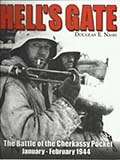Hell's Gate: The Battle of the Cherkassy Pocket
 By Douglas E. Nash
By Douglas E. Nash
RZM Imports, 2001
390 pp.,
ISBN 0965758435
Reviewed by Michael Peck
This is the story of the mini-Stalingrad that almost was. The battle of the Cherkassy pocket had all the ingredients of an epic battle: an encircled army battling against heavy odds, a relief force struggling to break the siege before it was too late, and finally a last do-or-die breakout. It would make a great Hollywood movie or History Channel documentary, except that few people know of the battle.
Hell's Gate goes a long way toward redressing this. In fact, this large-size, 420-page tome will likely be the definitive work on this battle for years to come. The campaign begins in January 1944, when the German armies in the East had steadily been pushed back through southern Russia into the Ukraine. Despite their being driven out of Kiev and their Dnieper River defenses, Hitler's suicidal never-retreat-an-inch dogma forced the exhausted, decimated Army Group South to hold the Kanev-Cherkassy salient bulging deep into Soviet lines. More than 130,000 men were in the bulge and along its flanks, including 65,000 within the salient itself.
Such a tempting target could not be ignored, and skilled Soviet commanders such as Zhukov and Konev didn't. Their First and Second Ukrainian Fronts mustered nearly three hundred thousand men with a superiority of 2:1 in manpower, 5:1 superiority in armor, 4:1 in aircraft and a staggering 7:1 artillery.
In the bitter cold of January 24th, 1944, the armies began a pincers offensive that penetrated the weak German lines at the base of the bulge and trapped the forces inside. The encircled Group Stemmermann held tight on while Von Manstein - perhaps the most skilled of all German commanders - scraped together the last armor of Army Group South to break the ring.
This was the phase of the Russo-German war where a curious asymmetry arose. Soviet strategy had evolved from the fumbling of 1941into the marvelously planned offensive that destroyed the German Sixth Army at Stalingrad. It was at the tactical and operational level that the Red Army lagged; it had progressed from rom the clumsy hordes of 1941, yet lacked the exquisite flexibility and finesse of their battle-hardened German opponents. The Wehrmacht remained masters of the battlefield into virtually the end of the war, but German strategy was corrupted by Hitler's meddling and flaws in the German command structure. Thus the 24th Panzer Division was ordered to slog through the mud from Nikopol to the Cherkassy relief force, only to be ordered to slog back when a furious Hitler learned that the division had been removed without his approval.
On the inside of the pocket, Group Stemmermann (mainly consisting of rear-area support units backed by some infantry and the crack 5th SS Panzer Division Viking) stubbornly resisted Soviet efforts to entice them into digestible pieces. On the outside, the Soviet besiegers fought grimly to hold the relieving German armor at bay. The weather went beyond hideous into inhuman. The experience and skill of the panzer crews were pitted against tenacious resistance and snowy ground melting into thick, gluey mud in a Stalinist Russia with few and primitive roads.